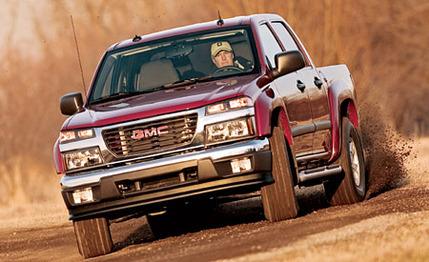
 Road Test
Road Test
We first clapped eyes on a Chevy S-10 in 1981, the Pleistocene epoch, a year in which we went embarrassingly gaga over a Renault Le Car and Csaba Csere was a fresh hire. If the S-10 were a young man, he'd today be old enough to view uncensored airings of the Super Bowl half-time show. And still GM refuses to ax the thing-a crew-cab S-10 lives for another year or so. The General is cautious about introducing new trucks like A.J. Foyt is cautious about Chinese hand tools.
But now, with the appearance of the GMC Canyon and its nearly identical sister, the Chevrolet Colorado, it's okay to forget about the rough-as-a-cob S-10. The Canyon/Colorado duo is styled with stubby overhangs, squared-off wheel openings, and the squinty four-eyed visage of the full-size Silverado and Sierra. They look a little like dazed rodeo bulls, brawny but lovable.
The platform here is genuinely new, shared with no other light truck or SUV in GM's vast repertoire. Three cab sizes are available-regular, extended, and crew-on two wheelbases. Two bed lengths are offered-73.0 inches and 61.0 inches. Two suspensions can be ordered-standard or the Z71 off-road version, which creates 9.3 inches of ground clearance fore and 8.4 inches aft. Two engines are available-a 175-hp DOHC in-line four and an all-alloy 220-hp DOHC in-line five, both derived from the straight-six in the TrailBlazer. And two transmissions are on tap-an Aisin five-speed manual or a Hydra-Matic four-speed automatic.
All Canyon/Colorado beds are 57.2 inches wide with a clever tailgate that can be locked at 55 degrees, where it stands at the same height as the rear wheelhouses. Four-by-eight-foot sheets of plywood can thus be stacked flat.
Our test truck arrived as a crew cab, with the off-road suspension, the 20-valve in-line five-cylinder engine, and an automatic. It otherwise sported few options, including OnStar ($695), an XM satellite radio ($325), a six-CD changer ($395), and a factory trailer hitch ($270). That was nevertheless sufficient to hoick its sticker north of 30 grand, a very scary plateau in this compact-pickup class.
Drive the Canyon and what you notice first is that it's far, far more solid than any S-10 ever built or imagined. Torsional rigidity is way up, with minimal bed shimmy, no shivers through the dash, no subassemblies in motion. The new body mounts are adept at blocking harshness transmitted through the frame. Impacts, right up to genuine slobber knockers, are distant, nontroubling events. Accidentally drop two wheels off the right side of the road? The Canyon doesn't care. Go ahead and drive all day like that.
This truck, at least by class standards, is also gratifyingly quiet, thanks in part to an aggressive sound-deadening program, including triple door seals that have reduced wind and tire roar. Rocks that once ricocheted into the wheel wells now make an echoless plink rather than the old metallic ker-whang. At idle and full throttle, the Canyon is quieter than any of the five "Compact Critters" we compared in August 1998. It offers an unexpectedly soothing cabin, rare for a class where "cheap" has more than one meaning, and it makes the uplevel sound systems worth contemplating. Audio quality, even from the base six-speaker system, is terrific.
The new in-line five idles at about 600 rpm, where it evinces a peculiar staccato backbeat that is felt more than heard. Crack the throttle a titch, up to 900 or so rpm, and the idle suddenly goes as smooth as Vaseline. At wide-open whack, the engine emits a curious lowing, like a cow with acid reflux. It needs to be about an octave lower and divorced from all 4-H club proceedings before 20-something males, rabid subscribers to the compact-truck class, will find it agreeably macho. This engine, with its twin balance shafts, is otherwise devoid of the mechanical clatter and thrash that afflicted all previous S-10 and Sonoma powerplants. It is subdued and carlike all the way to its 6100-rpm redline.